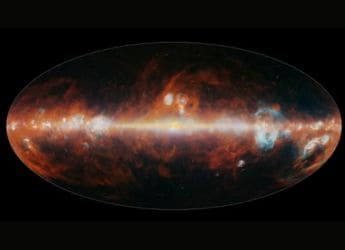- Home
- Science
- Science News
- How Did Heavy Metals Like Gold, Uranium Form? Research Says Answer Lies in Black Holes
How Did Heavy Metals Like Gold, Uranium Form? Research Says Answer Lies in Black Holes
While heavy metals were formed inside stars or collision of neutron stars, the question remains if they can be produced in any other way

Photo Credit: Unsplash/ Jingming Pan
Certain black holes orbited by an accretion disc may synthesise heavy metals
A question that has often intrigued scientists is from where do all the heavy metals, including gold and uranium, come from? How did they originate? While all heavy metals have formed under extreme conditions inside stars or due to stellar explosions and collision of neutron stars, the question remains: when and why was the material ejected and whether heavy elements can be produced in any other way. Researchers now say that the synthesis of heavy elements is typical for certain black holes orbited by an accretion disc of dense and hot matter.
While a black hole is a region where gravity is so strong that nothing can escape from it, the accretion disc is composed of material which has come close to a black hole but not fallen into it. This system is formed by the merger of two massive neutron stars or during the collapse and explosion of a rotating star. Researchers from Germany's GSI Helmholtz Centre for Heavy Ion Research and their colleagues from Belgium and Japan said that the internal composition of such accretion discs has so far not been well understood.
“In our study, we systematically investigated for the first time the conversion rates of neutrons and protons for a large number of disc configurations by means of elaborate computer simulations, and we found that the discs are very rich in neutrons as long as certain conditions are met,” Dr Oliver Just, from the Relativistic Astrophysics group of GSI's research division, told Phys.org.
Just said the decisive factor is the total mass of the disc, meaning the bigger the disc, the more often neutrons are formed and are available for the synthesis of heavy elements.
The study shows that the optimal disc mass for prolific production of heavy elements is about 0.01 to 0.1 solar masses. It provides strong evidence that neutron star mergers producing accretion discs with these exact masses could be the point of origin for a large fraction of the heavy elements. However, it is not yet clear whether and how frequently such accretion discs occur.
The findings have been published in the Monthly Notices of the Royal Astronomical Society journal.
Get your daily dose of tech news, reviews, and insights, in under 80 characters on Gadgets 360 Turbo. Connect with fellow tech lovers on our Forum. Follow us on X, Facebook, WhatsApp, Threads and Google News for instant updates. Catch all the action on our YouTube channel.
- Samsung Galaxy Unpacked 2025
- ChatGPT
- Redmi Note 14 Pro+
- iPhone 16
- Apple Vision Pro
- Oneplus 12
- OnePlus Nord CE 3 Lite 5G
- iPhone 13
- Xiaomi 14 Pro
- Oppo Find N3
- Tecno Spark Go (2023)
- Realme V30
- Best Phones Under 25000
- Samsung Galaxy S24 Series
- Cryptocurrency
- iQoo 12
- Samsung Galaxy S24 Ultra
- Giottus
- Samsung Galaxy Z Flip 5
- Apple 'Scary Fast'
- Housefull 5
- GoPro Hero 12 Black Review
- Invincible Season 2
- JioGlass
- HD Ready TV
- Laptop Under 50000
- Smartwatch Under 10000
- Latest Mobile Phones
- Compare Phones
- Huawei Nova 15
- Huawei Nova 15 Pro
- Huawei Nova 15 Ultra
- OnePlus 15R
- Realme Narzo 90x 5G
- Realme Narzo 90 5G
- Vivo S50 Pro Mini
- Vivo S50
- Asus ProArt P16
- MacBook Pro 14-inch (M5, 2025)
- Huawei MatePad 11.5 (2026)
- OnePlus Pad Go 2 (5G)
- OnePlus Watch Lite
- Just Corseca Skywatch Pro
- Acerpure Nitro Z Series 100-inch QLED TV
- Samsung 43 Inch LED Ultra HD (4K) Smart TV (UA43UE81AFULXL)
- Asus ROG Ally
- Nintendo Switch Lite
- Haier 1.6 Ton 5 Star Inverter Split AC (HSU19G-MZAID5BN-INV)
- Haier 1.6 Ton 5 Star Inverter Split AC (HSU19G-MZAIM5BN-INV)












